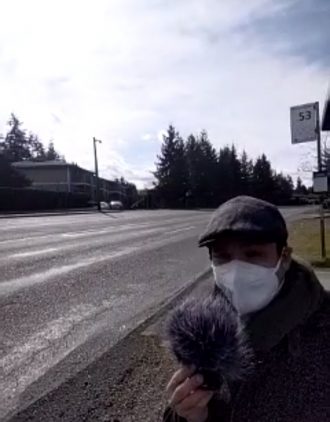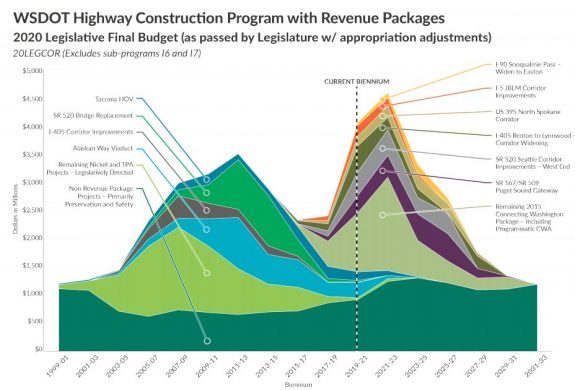
At a press event in Tacoma at a bus stop next to fast-moving traffic, with no actual sidewalk available for people to use to access the bus stop, Disability Rights Washington & Front and Centered outlined their priorities today for the statewide transportation package moving through the legislature this year: “No new highways until we have sidewalks and reliable transit service”.
Paulo Nunes-Ueno, Transportation and Land Use Policy Lead for Front and Centered, the largest coalition of communities of color-led groups in the Pacific Northwest, identified the gravel-covered curb as “unfinished business” that Washington governments hadn’t prioritized in part because of the 18th Amendment to the State Constitution, passed in 1944, that ties the the state’s gas tax to highway projects. “The way we have funded transportation has left out too many people, most often people of color and poorer communities but also everyone who doesn’t drive”.
Krystal Monteros, Chair of Tacoma’s Commission for People with Disabilities, shared her experience living across the street from the spot where the event was held: “The sidewalk across from my apartment is still messed up”, limiting her movement. Disability Rights Washington has created an invaluable storymap talking to people in every legislative district in the state who can’t drive, sharing the stories of those vastly underserved by our transportation infrastructure currently. The map is an essential resource, particularly for lawmakers deciding where to allocate scarce dollars.
The press conference today comes on the heels of Governor Jay Inslee holding one last week with area leaders to push for a “maintenance first” transportation package. “We are getting our vaccines. Now we need to get our roads, bridges and ferries. All of these things are necessary for the rebuilding of Washington state’s economy. We need to make the investments first, and I emphasize first, in maintenance of our existing transportation system…it is woefully underfunded.”
But even a heavily maintenance-focused package in 2021 would not be putting maintenance first, after highway spending has ramped up steadily under the Governor’s watch. A chart from WSDOT Secretary Roger Millar’s State of Transportation address to the legislature this year showed more highway spending planned during the 2021-2023 biennium than ever before, with numerous mega-projects prioritized over preservation and maintenance.

WSDOT’s active transportation plan, released in draft form late last year, outlined just how improvements to make our state highways usable for people who are rolling, walking or biking stack up against the spending we’ve already allocated to highway expansion projects. Roger Millar, at last week’s press conference, cited a $300 million price tag on the I-5 bridge over the ship canal to get the facility in a “state of good repair”; contrast that with a $283 million price tag to add speed treatments to every single state highway through a population center in Washington. Separated pedestrian and bike facilities everywhere come in at $1.8 billion, comparable to many high-profile highway expansion projects considered by the state in recent years.
Front and Centered and Disability Rights Washington’s call for no new spending on highways in Washington is a bolder request than we have seen from other transportation advocacy organizations in recent months. The Clean & Just Transportation Table, established by the Climate Alliance for Jobs and Energy, made up of 205 statewide orgs (including Front and Centered), and promoted by Transportation Choices Coalition, has highlighted the fact that Washington’s transportation spending is “inadequate, inflexible, and inherently inequitable” but has stopped short of calling for a moratorium on highway expansion. Alex Hudson, TCC’s Executive Director, signed onto a joint op-ed in the Seattle Times last month that left the door open to specific megaprojects: “Many larger projects, such as a new I-5 bridge over the Columbia River, an improved Highway 2 trestle in Snohomish County and repairing the West Seattle Bridge are also essential to congestion relief, safety and commerce.”
The Washington House Democrats‘ transportation package remains the most progressive proposal on the table, with billions more in spending for transit, bike, and pedestrian infrastructure than the state has ever seen at the state level. But it does include billions of dollars in new highway projects as well. Contrast that with the proposal Senator Steve Hobbs has unveiled as chair of that body’s transportation committee, which includes half as much money for multimodal priorities and billions more for highway projects.
With pressure from the Governor to get a transportation package, we should expect to see the committees scramble to assemble a coalition that can pass both chambers by the end of the legislative session on April 25.
Until every bus stop in our state is accessible, not a single dollar should go towards expanding highways. #MobilizeWA pic.twitter.com/uTHBwNuShs
— Disability Mobility Initiative (@non_drivers) March 10, 2021












Comments
6 responses to “New coalition forms to oppose new highway spending over sidewalks and transit”
The 18th Amendment is irrelevant: https://washingtonstatewire.com/supreme-court-ruling-says-gas-taxes-not-just-for-highways-anymore/. We could spend all the gas tax money on poodles if we wanted to, as long as we made clear the money was going for poodles.
“A chart from WSDOT Secretary Roger Millar’s State of Transportation address to the legislature this year showed more highway spending planned during the 2021-2023 biennium than ever before, with numerous mega-projects prioritized over preservation and maintenance.”
The chart mostly just shows a huge “miscellaneous” category. The first three projects are largely just plain old road projects (I-90 to Easton, JBLM and US 395). In some cases these are excessive, but not horribly so. The big stinker is the 167/509. It should never have been built. It epitomizes the “just build another freeway and traffic will be fine” mentality. But I’m pretty sure the 405 project is an HOV project. It is being built so that the buses (and carpools can go faster). The 520 project is a mix of maintenance and HOV (the HOV really isn’t needed, since light rail does the same thing, but I’m sure being HOV helped them get it done).
But by far the biggest projects are “Remaining 2015 Connecting Washington Package — Including Programmatic CWA” and “Non-Revenue Package Projects — Primarily Preservation and Safety”. What the heck are these things? I’m not a reporter — I’m just asking. Those two projects (or categories) make up the bulk of the spending, and I have no idea what it for.
Without a doubt there is pork, and really bad decision making that went into the last transportation proposal. The 167/509 project should have been headline news for websites like this. But most of the projects are maintenance or HOV based (so far as I know). Likewise, the big question with the US2 trestle is whether they will focus on maintenance only, or add a lane each direction for buses/carpools. I could go either way. Should we spend a bunch of money so that relatively few people in the suburbs can have a faster bus rid, or focus on sidewalks and the like? Hard to say.
A quick web search turned up these:
2015 Connecting Washington Package:
https://wsdot.wa.gov/construction-planning/funding/connecting-washington
WA transportation funding sources:
https://infrafunding.wa.gov/downloads/Transportation-Funding-Sources-WA.pdf
Couldn’t find “non-revenue package projects”, but think the “non-revenue” part probably means not funded by gas tax or tolls. Just guessing.
We’re in a rare time where we have a reprieve from constantly increasing traffic. After the pandemic, I think it’s pretty reasonable to assume traffic will not jump back to pre pandemic levels. Many people will continue to telework part time.
We should take advantage of this and route as many funds as possible to pedestrian improvements and maintenance. SDOT does an atrocious job. Even at the highly popular fremont bridge, the approach sidewalks still have rotting leaves from last fall.
It’s hard to tell from the chart above which projects could be defunded. And some of them probably include pedestrian improvements. And a few probably are truly essential for our overall sustainability: the I5 bridge and the West Seattle bridge.
I hope more details can come from this and we can get more sidewalks, more bike lanes, and safer streets.
It is interesting to read the 18th Amendment and case law. It’s past time for the State to recognize that the amendment says that the fuel tax is for SAFE and efficient operation of highways, not just efficient.
Sidewalks and separation of bike ways are just as important for safety as is grade separation of railroads from highways. A highway or city street is not just the vehicle roadway. It is the entire right-of-way, including the right of people on foot to have a way. Motor vehicle use causes the safety problems for other users, so it’s reasonable for motor vehicle users to pay for costs of safety improvements.
To quote a dissenting justice in a 1969 case at the height of auto lobby influence, “neither the common nor the legal understanding of “highway purposes” is restricted to the physical construction and maintenance of roadways for vehicles driven by petroleum-fueled internal-combustion engines as they were operated and administered in 1944,…”. [State ex rel. O’Connell v. Slavin, 75 Wn. 2d 544]. Times change.
The definition of highway adopted by WA courts:
“A highway is a way open to the public at large, for travel or transportation, without distinction, discrimination, or restriction, except such as is incident to regulations calculated to secure to the general public the largest practical benefit therefrom and enjoyment thereof. Its prime essentials are the right of common enjoyment on the one hand and the duty of public maintenance on the other. It is the right of travel by all the world, and not the exercise of the right, which constitutes a way a public highway, and the actual amount of travel upon it is not material. If it is open to all who desire to use it, it is a public highway although it may accommodate only a limited portion of the public or even a single family or although it accommodates some individuals more than others.”
[State ex rel. Oregon-Wash. R.R. & Nav. Co. v. Walla Walla Cy., 5 Wn.2d 95, 104 P.2d 764 (1940), which was taken from 25 Am. Jur. Highways § 2 (1940).]
https://leg.wa.gov/JTC/trm/Documents/TRM%202017%20Update/7%20-%2018th%20Amendment-Final.pdf
Excellent points. This supports not only bike lanes on suburban and rural highways, but also sidewalks and bike lanes, even traffic calming, on highways in urban areas. !!!